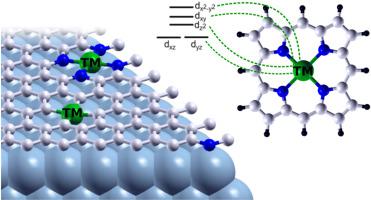Our official English website, www.x-mol.net, welcomes your
feedback! (Note: you will need to create a separate account there.)
Single Atom Catalysts (SAC) Trapped in Defective and Nitrogen-doped Graphene Supported on Metal Substrates
Carbon ( IF 10.5 ) Pub Date : 2020-12-01 , DOI: 10.1016/j.carbon.2020.12.045 Anu Baby , Laura Trovato , Cristiana Di Valentin
Carbon ( IF 10.5 ) Pub Date : 2020-12-01 , DOI: 10.1016/j.carbon.2020.12.045 Anu Baby , Laura Trovato , Cristiana Di Valentin

|
Abstract Single Atom Catalysts (SAC) in graphene have been recently gaining more and more attention. They are usually non-noble transition metal (TM) adatoms getting trapped at the carbon vacancies during the fabrication of the graphene layer, which then act as active centers for catalysis and adsorption. In this work we present a systematic and comparative investigation, by means of dispersion–corrected density functional theory (DFT) calculations, of Fe, Co, Ni, and Cu as possible SACs when they become trapped at graphene C vacancies. The stability of these TM atoms is further increased by introducing pyridinic nitrogen (N) atoms and transforming graphene into a giant porphyrin-like macrocyclic ligand. The structural, electronic and energetics properties of these systems, even under the effect of a metal substrate (weakly interacting Cu (111) or strongly interacting Ni (111)), are comparatively examined in great detail by means of crystal/ligand field theories and through ad-hoc energy decomposition analysis to highlight trends and peculiar behaviors. The position of the TM d-orbitals with respect to the Fermi level of the whole system is of considerable importance for designing prospective device applications in catalysis, electrocatalysis and sensors. To this purpose, we also examine how the reactivity of the SACs in graphene towards the hydrogen evolution reaction (HER) can be tuned with N-doping and with different substrates.
中文翻译:

单原子催化剂 (SAC) 被困在金属基板上支撑的有缺陷和氮掺杂的石墨烯中
摘要 石墨烯中的单原子催化剂(SAC)最近受到越来越多的关注。它们通常是在石墨烯层的制造过程中被困在碳空位处的非贵重过渡金属 (TM) 吸附原子,然后充当催化和吸附的活性中心。在这项工作中,我们通过色散校正密度泛函理论 (DFT) 计算对 Fe、Co、Ni 和 Cu 作为可能的 SAC 进行了系统的比较研究,当它们被困在石墨烯 C 空位时。通过引入吡啶氮 (N) 原子并将石墨烯转化为巨大的类卟啉大环配体,这些 TM 原子的稳定性进一步提高。这些系统的结构、电子和能量学特性,即使在金属基材(弱相互作用的 Cu (111) 或强相互作用的 Ni (111))的影响下,也可以通过晶体/配体场理论和特别的能量分解分析进行比较详细的比较,以突出趋势和奇特的行为。TM d 轨道相对于整个系统的费米能级的位置对于设计催化、电催化和传感器中的预期设备应用非常重要。为此,我们还研究了石墨烯中 SAC 对析氢反应 (HER) 的反应性如何通过 N 掺杂和不同的底物进行调节。通过晶体/配体场理论和特别的能量分解分析,比较详细地比较了研究,以突出趋势和特殊行为。TM d 轨道相对于整个系统的费米能级的位置对于设计催化、电催化和传感器中的预期设备应用非常重要。为此,我们还研究了石墨烯中 SAC 对析氢反应 (HER) 的反应性如何通过 N 掺杂和不同的底物进行调节。通过晶体/配体场理论和特别的能量分解分析,比较详细地比较了研究,以突出趋势和特殊行为。TM d 轨道相对于整个系统的费米能级的位置对于设计催化、电催化和传感器中的预期设备应用非常重要。为此,我们还研究了石墨烯中 SAC 对析氢反应 (HER) 的反应性如何通过 N 掺杂和不同的底物进行调节。
更新日期:2020-12-01
中文翻译:

单原子催化剂 (SAC) 被困在金属基板上支撑的有缺陷和氮掺杂的石墨烯中
摘要 石墨烯中的单原子催化剂(SAC)最近受到越来越多的关注。它们通常是在石墨烯层的制造过程中被困在碳空位处的非贵重过渡金属 (TM) 吸附原子,然后充当催化和吸附的活性中心。在这项工作中,我们通过色散校正密度泛函理论 (DFT) 计算对 Fe、Co、Ni 和 Cu 作为可能的 SAC 进行了系统的比较研究,当它们被困在石墨烯 C 空位时。通过引入吡啶氮 (N) 原子并将石墨烯转化为巨大的类卟啉大环配体,这些 TM 原子的稳定性进一步提高。这些系统的结构、电子和能量学特性,即使在金属基材(弱相互作用的 Cu (111) 或强相互作用的 Ni (111))的影响下,也可以通过晶体/配体场理论和特别的能量分解分析进行比较详细的比较,以突出趋势和奇特的行为。TM d 轨道相对于整个系统的费米能级的位置对于设计催化、电催化和传感器中的预期设备应用非常重要。为此,我们还研究了石墨烯中 SAC 对析氢反应 (HER) 的反应性如何通过 N 掺杂和不同的底物进行调节。通过晶体/配体场理论和特别的能量分解分析,比较详细地比较了研究,以突出趋势和特殊行为。TM d 轨道相对于整个系统的费米能级的位置对于设计催化、电催化和传感器中的预期设备应用非常重要。为此,我们还研究了石墨烯中 SAC 对析氢反应 (HER) 的反应性如何通过 N 掺杂和不同的底物进行调节。通过晶体/配体场理论和特别的能量分解分析,比较详细地比较了研究,以突出趋势和特殊行为。TM d 轨道相对于整个系统的费米能级的位置对于设计催化、电催化和传感器中的预期设备应用非常重要。为此,我们还研究了石墨烯中 SAC 对析氢反应 (HER) 的反应性如何通过 N 掺杂和不同的底物进行调节。


















































 京公网安备 11010802027423号
京公网安备 11010802027423号